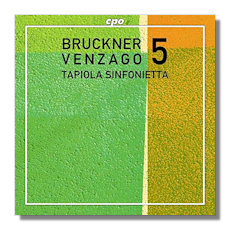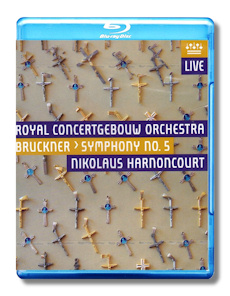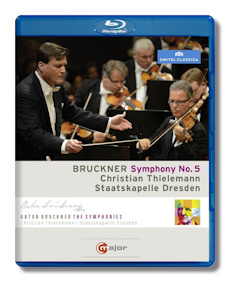
The Internet's Premier Classical Music Source
Related Links
- Bruckner Reviews
- Latest Reviews
- More Reviews
-
By Composer
-
Collections
DVD & Blu-ray
Books
Concert Reviews
Articles/Interviews
Software
Audio
Search Amazon
Recommended Links
Site News
 Blu-ray Review
Blu-ray Review
It would be hard to imagine three more different performances of Bruckner's Symphony #5 in B Flat Major. With this recording Mario Venzago brings his iconoclastic cycle to a close, consciously setting himself against almost every current and past approach to Bruckner interpretation. Harnoncourt is less conspicuously revolutionary, but still wedded to a more historically informed performance style. Thielemann, in contrast, gives us Bruckner in the grand style.
I reviewed Venzago's recording of the Eighth Symphony (CPO 777691-2). I was unconvinced, but not wholly negative. I have the same reaction here. As he states in the lengthy essay explaining his approach, Venzago plays Bruckner much faster than we are accustomed to. His model is Schubert's Unfinished, which he thinks has likewise been excessively slowed down by generations of conductors. He also favors a relatively small orchestra, with some 30 strings, as was more standard during Bruckner's lifetime, and argues that the slower pace we have become used to is a function of excessively large orchestras. In sum, Venzago sets himself against the kind of cathedral interpretation so well-articulated by Benjamin Zander in the long interview accompanying his performance of the Fifth (Telarc 80706).
This is by quite some way the fastest performance of Bruckner's Fifth ever recorded. It comes in at 60 minutes even. For comparison, the Bruckner Discography shows only a handful of performances coming in under 70 minutes, with the majority significantly longer. The first movement speeds by in a blur at 15:55 (nearly seven minutes quicker than Thielemann, for example, and five minutes quicker than Harnoncourt). The slow movement takes some getting used to, but the final movements are very effective, bringing out very clearly Bruckner's adventurous harmonies. The Scherzo benefits from the pace, but it's worth noting that the Scherzo is longer than the Adagio. One of the claims that Venzago makes for his approach is that it better allows the counterpoint to emerge. There is some truth in this, but the overall effect of the final movement is not good. The pace sounds forced. Venzago seems to have forgotten that Bruckner was an organist.
Whereas the Venzago disc is a studio recording, the other two performances are both recorded live. Harnoncourt's concert is a historic event – his farewell performance after 38 years and 276 concerts with the Concertgebouw. Like Venzago, Harnoncourt aims to strip away some of the Romantic excesses with which Bruckner has become encrusted. His style is much less mannered, however, and his personality does not intrude much into the music. One of Harnoncourt's trademarks is minimal vibrato in the strings. As a result he loses some of the grandeur of the slow movement. But it undeniably yields a clean and crisp sound. This is entirely appropriate for Harnoncourt, who focuses more on vertical than on horizontal structure. This is a very polished performance – one that does credit both to the occasion and to the score.
Thielemann takes a much more orthodox and weighty approach. The timings tell the story, with the Staatskapelle Dresden taking 82 minutes, more than 22 minutes longer than Venzago and nearly 15 longer than Harnoncourt. The principal divergence is in the slow movement, to which Venzago and Harnoncourt devote less than 13 minutes, while Thielemann takes over 20. Unsurprisingly Thielemann achieves a weight in the Adagio that neither of the other two can come close to matching. This helps him achieve a much more satisfying architectural balance across the four movements – Thielemann very much focuses on horizontal structure. The third movement also achieves a fine balance, with the contrast between the Scherzo and the Trio well judged.
The Finale is also longer in the Dresden performance. Here too Thielemann brings the overall structure out very clearly. There is a tremendous build up at the opening of the movement and the two fugal passages play their role in a very complex movement, rather than stealing the show. I certainly found this the most satisfying of the three performances – helped no doubt by being well filmed in the fine surroundings of the Semperoper in Dresden.
Copyright © 2015, José Luis Bermúdez
























